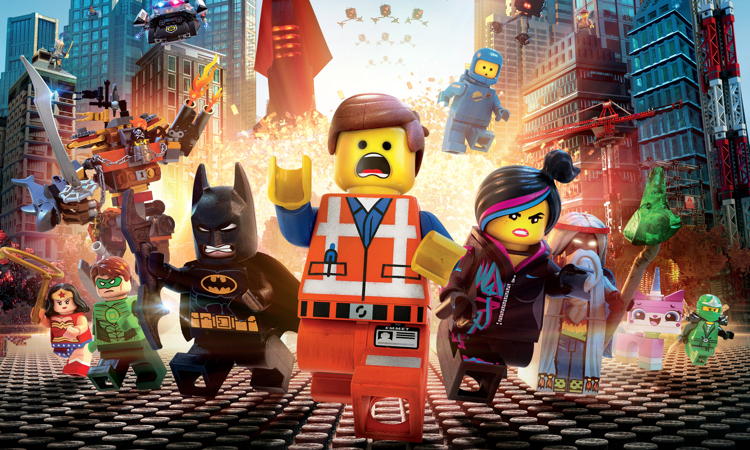By Jim Rohner · February 11, 2014

Emmet Brickowski (Chris Pratt) is just an ordinary citizen of Bricksburg. Like every other citizen, he’s into ordinary things like greeting the day with a smile and watching “What Happened to My Pants?” and eating chicken wings at bars with his co-workers and being sure to always follow instructions whether it be 11 steps to be liked by everyone or sticking to the blueprints at his construction job. Yup, Emmet is so ordinary that you’d lose him in a crowd amongst the countless other citizens of Bricksburg. He’s so ordinary, that the people he encounters on a daily basis can’t seem to pinpoint any worthwhile talking points about him. He’s so ordinary, that you might say that’s absolutely nothing special about him.
So, of course he’s the hero of The Lego Movie.
Read More: Best Movies Based on Real-Life Toys
This may be hard to believe at first; after all, Wyldstyle (Elizabeth Banks) certainly doesn’t believe that the guy who’s greatest idea is the double-decker couch could ever possibly be “The Special”, the one prophesied by Vitruvius (Morgan Freeman) to foil the evil world domination plans of corporate overlord, President Business (Will Ferrell). For one thing, Emmet, unlike wise Vitruvius and, well, wild Wyldstyle, isn’t even a Master Builder, a quickly and ominously disappearing group of individuals gifted with the ability to construct anything from anything without instructions. Here’s a guy who accidentally literally stumbled upon the Piece of Resistance, the one and only relic with the power to stop The Kragle, the doomsday machine that President Business will use to freeze the universe permanently in place. For another thing, the double-decker couch? That’s literally the dumbest thing I’ve ever heard. I mean, would the people on top have to climb over the others to get the ladders on the side? Would the people on the bottom have to watch TV through dangling feet?
Anyway, Emmet, thankfully, won’t have to take this journey alone. Joining him in his quest are some other Master Builders, some of the few who have escaped and remained at large after President Business sealed off access to lands outside of Bricksburg: there’s Benny (Charlie Day), the easily excitable spaceman who just wants to build spaceships; there’s Unikitty (Alison Brie), whose bubbly personality belies some serious suppressed darkness; there’s Batman (Will Arnett), Wyldstyle’s serious boyfriend who only builds in black (and sometimes, very, very dark grey); and then there’s Metal Beard (Nick Offerman), the former pirate/present pirate ship robot whose head is the only thing that survived the last assault on President Business’s tower. Each Master Builder has the extraordinary ability to create anything they can think of relevant to their special skills. But perhaps the world doesn’t need someone extraordinary. Maybe the world needs someone ordinary.
Admittedly, that premise – in a world of extraordinary people, we need an ordinary blah blah blah – sounds cliched, and it is, but that doesn’t mean that it doesn’t work to the benefit of The Lego Movie. A major Hollywood studio release with refreshing levity, The Lego Movie is self-aware enough of the tropes of blockbuster summer movies to embrace what works and poke fun of what doesn’t to the end of further enjoyment. The Lego Movie is the kind of film where the Good Cop/Bad Cop archetype is personified (for lack of a better term) in a cop (Liam Neeson) who literally has two faces: a hard as nails Bad Cop with anger issues he hilariously takes out on inanimate objects, and a gee whiz Good Cop with glasses and a fondness for his retired police mom and pop. It’s also the kind of movie with car chases, spaceships, robots, superheroes, laser guns, ship wrecks and explosions, every single one of which made up of individual Lego pieces.
But The Lego Movie isn’t just about spectacle. Even Michael Bay boasted that the robots from Transformers were painstakingly manufactured to ensure the physical dimensions of the automobiles matched up physically and mechanically to their ‘splosiony other forms. Getting past the intricate construction of literally everything (beautiful as it is) and the verbal play on action films past (“come with me if you want to not die”), you’ll find the standard themes rehashed and revisited in practically every film suitable for children: believe in yourself, working together is better than working alone, good is better than evil, etc. etc. and such. Coming from any other animated film, it’d be nature for your adult response to be, “well, that was cute, but…” and attach something referring to the message’s redundancy over-simplicity. But when it comes to Legos, a toy that arguably more so than any other fosters the use of imagination and drawing outside the lines, the message takes on a bit more resonance and meaning.
Yes, The Lego Movie says that being yourself is especially important in the face of adversity and yes, people’s individual talents are even better when joined together with others, but most importantly The Lego Movie encourages imagination and praises the spirit of creativity. Emmet is not set apart because he can do one specific thing better than anyone, but because he recognizes that everyone can contribute, that in the face of extraordinary, ordinary is its own form of uniqueness and specialty. The evil force descending on Bricksburg is not destruction – not explicitly, at least – but conformity, the idea that there is one way things should go and those things only have merit by fulfilling one expectation. The joy in The Lego Movie, and its real world application both on and off screen, is in heterogeneity, in thinking outside the lines, in wondering, “what if?” and then trying it out. As the infectiously catchy pop song in Bricksburg declares, “Everything is Awesome,” (emphasis mine), and its great to see a movie that genuinely believes it.